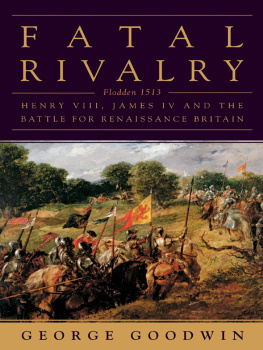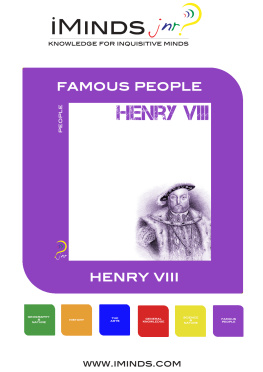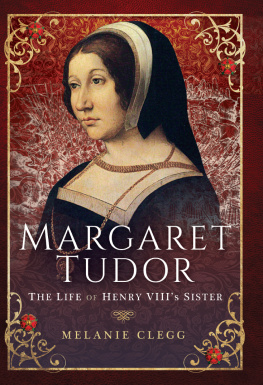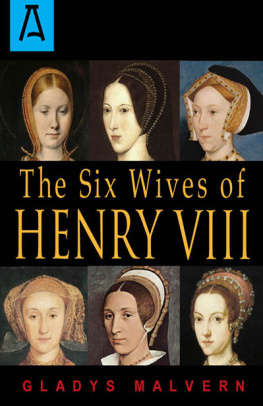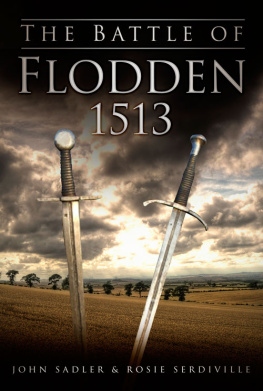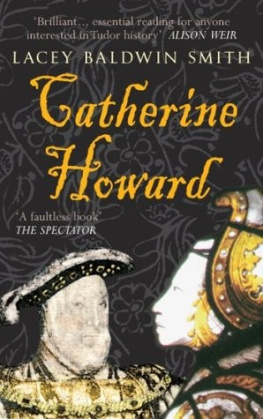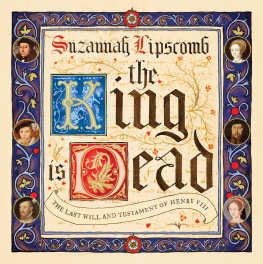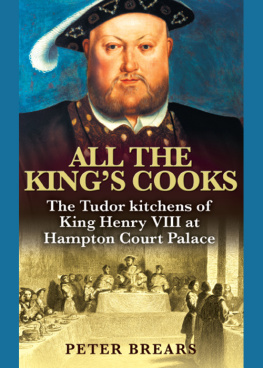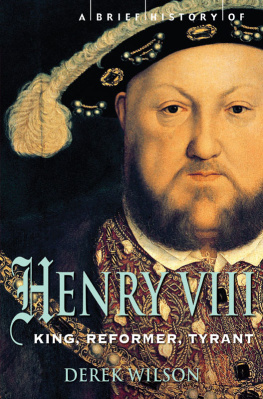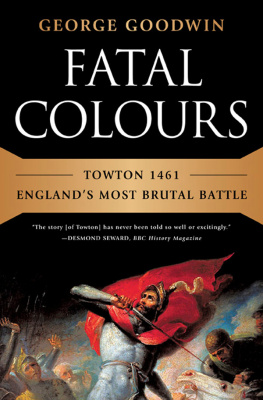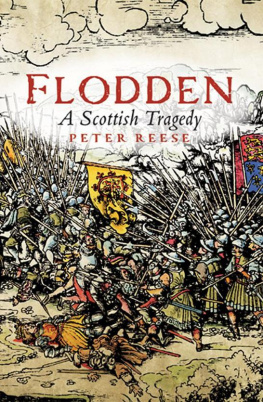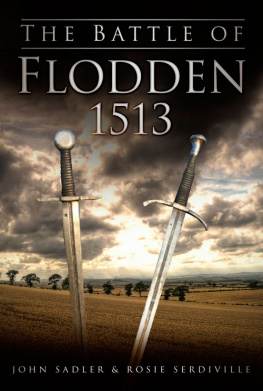
By the same author
Fatal Colours: Towton 1461
FATAL RIVALRY
HENRY VIII, JAMES IV AND THE BATTLE FOR RENAISSANCE BRITAIN
Flodden 1513
George Goodwin

For Arthur, Cecily and Frances
CONTENTS
1. Portrait of Henry VII ( English School/Getty Images )
2. Portrait of James IV by Mytens ( Collection of the Stirlings of Keir )
3. Portrait of Margaret Tudor ( Royal Collection Trust/Her Majesty Queen Elizabeth II 2013 )
4. The royal arms of England of Henry VII ( The British Library Board, Royal 19 B. XVI )
5. The Cloth of the Estate at Stirling Castle, featuring the arms of James IV ( dun_deagh )
6. Portrait of Richard Fox by Hans Corvus, c.1530 ( Corpus Christi College, Oxford, UK/Bridgeman Art Library )
7. Portrait of Thomas Howard, Earl of Surrey ( His Grace The Duke of Norfolk, Arundel Castle / The Bridgeman Art Library )
8. Portrait of Cardinal Wolsey by Sampson Strong ( By permission of the Governing Body of Christ Church, Oxford )
9. Model of Richmond Palace ( Museum of Richmond )
10. The Great Hall of Stirling Castle ( Crown Copyright Historic Scotland, reproduced courtesy of Historic Scotland www.historicscotlandimages.gov.uk )
11. Detail from The Resurrection showing Alexander VI, Bernardino Pinturicchio, c.14925 ( AKG Images )
12. Portrait of Pope Julius II by Raphael, 1511 ( National Gallery, London, UK/Bridgeman Art Library )
13. Portrait of Pope Leo X by Raphael Sanzio, c.151819 ( AKG Images )
14. Terracotta bust of young Henry VIII by Guido Mazzoni, c.1498 ( Royal Collection Trust/Her Majesty Queen Elizabeth II 2013 )
15. Portrait of young Henry VIII, c.1513 ( The Berger Collection/Denver Art Museum )
16. Portrait of Erasmus by Holbein, 1523 ( Bridgeman Art Library )
17. Portrait of Katherine of Aragon by Michael Sittow, c.1510 ( AKG Images/Erich Lessing )
18. Portrait of Henry VIII, c.1520 ( National Portrait Gallery, London )
19. Portrait of James IV ( Faculty of Advocates Abbotsford Collection Trust )
20. A James IV gold coin, 1513 ( The Trustees of the British Museum )
21. Model of the Great Michael ( National Museums Scotland )
22. Painting of the Mary Rose by Geoff Hunt ( Mary Rose Trust )
23. Portrait of Emperor Maximilian I by Albrecht Drer, 1519 ( AKG Images/Nimatallah )
24. Book illumination showing Louis XII on the way to Genoa ( AKG Images )
25. Portrait of Philip the Fair and Margaret of Austria ( The National Gallery, London/AKG Images )
26. Portrait of Thomas Howard, 3rd Duke of Norfolk by Holbein ( His Grace the Duke of Norfolk, Arundel Castle/Bridgeman Art Library )
27. Portrait of Sir Brian Tuke by Holbein, c.1527
28. The Wound Man ( Dr Jeremy Burgess/Science Photo Library )
29. The Flodden Monument ( Clive Hallam-Baker )
30. The rain-soaked battlefield at Flodden ( Clive Hallam-Baker )
Late in the evening of Saturday, 26 March 1603, a dirty, bloody and dishevelled horseman of mature years arrived at Holyrood Palace in Edinburgh. That this was a gentleman of distinction was shown by the quality of the material, if not the condition, of his clothes. He demanded to be taken immediately to see James VI, King of Scots, and although the King was already in bed, James was wakened to receive him.
The gentleman rider was Sir Robert Carey, Warden of the English Middle March. He was also Captain of the Border castle of Norham in the East March a fortress reduced to ruins in 1513 by the invading army of King Jamess great-grandfather, James IV. Sir Robert was well known to James VI; as a young man, during an English diplomatic mission, he had got on famously with the King. So well in fact that James had written to Elizabeth I to ask whether Carey could attend on him at his court more permanently. Elizabeth had considered the matter with her usual deliberation and then refused the request. But Jamess relationship with Sir Robert and his family continued; and it was to Sir Roberts sister Philadelphia, Lady Scrope, that he sent a sapphire ring, to be returned urgently when the elderly English Queen had breathed her last.
Elizabeth had refused to nominate her successor throughout her near forty-five-year reign. Yet, at her magnificent Renaissance palace of Richmond in the small hours of the morning of Thursday, 24 March, she made a sign. To those crowded around the death bed, including Sir Robert and his sister, this was taken to favour her nearest in blood, King James. Though it was almost certain that the Privy Council would send formal notification to James, the Careys did not risk a delay. While the Council met, Lady Scrope waited at a window until she saw that her brother was outside the palace gates and could not be stopped. Then, furtively and unseen, she threw the blue ring to him. By ten oclock that same Thursday morning, Carey was riding north at a furious pace. As early as noon on the Saturday he had reached Norham on the Tweed. He crossed the border and would have travelled the remaining forty-five or so miles rather more quickly, had his horse not stumbled, thrown and kicked him. Weak with loss of blood from a head wound, he was forced to ride more slowly, making his arrival much later than planned.
The existence of the sixteenth-century Palace of Holyrood and Careys mission in 1603 were both consequences of one event: the palace had been created to celebrate the wedding, a century before, of James IV of Scotland and Margaret Tudor, the eldest daughter of Henry VII of England. It was because of James VIs descent from Margaret, his great-grandmother, that Sir Robert Carey knelt before him now and saluted him by his title of King of England, Scotland, France and Ireland.
The formal offer of the Crown from the Privy Council duly followed; and just a few days afterwards, on Tuesday, 5 April, James left Edinburgh. Late the following afternoon, the King approached Berwick with an ever-increasing host of Scottish and English dignitaries. He then crossed into his new kingdom;

The likelihood and consequences of a Scottish succession had been discussed by Henry VII and his Privy Council more than a century earlier. This was in 1501, a full two years before Jamess marriage to Margaret. As reported by their contemporary, the historian Polydore Vergil, there was a tense debate among the Kings councillors:
Some were afraid that at a future date it might come about that the inheritance of the kingdom might fall to Margaret, and therefore they judged it wise not to give her in marriage to a foreign prince. But the Kings answer to this was, What then? If this happens, which God forbid, I foresee that our realm will suffer no harm, since it will not be the addition of England to Scotland, but rather of Scotland to England as the most renowned part of the whole island, since it is always the less which is joined for glory and honour to that which is greater, just as in days gone by Normandy came under the rule of our English ancestors. The wisdom of the King was praised, and by a unanimous voice they plighted the maid Margaret to King James.
Henry VII was not quite right: though the crowns were united in 1603, the countries did not come together in an Act of Union, as Great Britain, until 1707. And even then they did so with different legal and educational systems and a degree of cultural separation. Scotland was not subsumed by England and much of the credit for that belongs to James IV. By 1513, his twenty-five-year reign had brought full royal control for the first time over what we know as the geographical entirety of Scotland. He was the owner of the largest warship in Europe and his country a naval power. And he had created the reality of an independent position for Scotland, rather than one of aspiration buttressed by myth. With these achievements, James IV can be properly described as King of Scotland as well as King of Scots. Had the schemes of King Louis XII of France borne fruit in 1513, James could have become the effective King of England as well.
Next page
